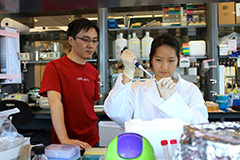Continuing education
By Alisa Kim
Summer officially kicks off in a month, but for undergraduates in the D+H Summer Student Research Program at Sunnybrook Research Institute (SRI), the season is here. In an orientation held May 23, Dr. Michael Julius, vice-president of research at Sunnybrook and SRI, welcomed students.
"It's a great pleasure to have you here," said Julius, to a packed audience in Sunnybrook's Harrison Hall lecture theatre. "Some of the people you're working with are the best on the planet. I would encourage you to interact with them and with each other."
Following him, program chair Dr. Jonathan Rast and graduate students from SRI's three research platforms gave SRI's newest employees pointers on how to get the most out of the summer studentship.
"Have fun and don't be afraid to ask lots of questions. This will not only help you, but it will [also] benefit the person answering those questions, because it forces us to think about why we do things in a particular way," said Korosh Kianizad, a PhD student in the lab of SRI senior scientist Dr. Juan Carlos Zúñiga-Pflücker.
In addition to learning the methods of a given scientific field, students will also become familiar with technologies within that field–from a pipettor, a staple of the biologist's tool kit, to advanced imaging equipment, such as a magnetic resonance imaging scanner. Students will also attend weekly seminars, where they can learn about the research SRI scientists are doing. Capping the program is the Best Summer Research Project competition, where students present posters with results of their projects and see what others have done. Winners from each of the platforms–Biological Sciences, Evaluative Clinical Sciences and Physical Sciences–receive $500 and individualized awards.
For Kaitlyn Lam, a third-year life sciences student at Western University, the opportunity to work in a medical research lab is far more valuable than a paycheque.
"When you're learning in the classroom, it's all conceptual. You don't get to see all the technology and procedures in action. Research is very hands-on, and you get to see how science is applied to everyday life. The whole field of cancer research is so exciting. That was definitely a big thing for me," said Lam, who is working in the lab of Dr. David Andrews, director of Biological Sciences at SRI.
Shobha Mehta, from Queen's University and also a third-year life sciences student, is working under the supervision of Dr. Martin Chapman, a researcher in the Trauma, Emergency & Critical Care Research Program. Her research will assess the effectiveness of the hospital's tracheostomy team. A tracheotomy is a procedure in which doctors create an opening in the neck, called a tracheostomy, and insert a tube into the windpipe to clear a blocked airway or deliver oxygen to the lungs safely.
Mehta, who said she plans to go into medicine, was struck by the way in which the clinical setting influences the research done at SRI. "It's so interconnected, and there are so many facets of research going on here. It's a huge facility, but you can feel how everyone wants the same thing out of their research," she said.
For Lam, working at a hospital-based research institute provides insight into the two career paths she is considering. "I want to keep my options open," she said. "This is a great opportunity to see whether research is right for me, or whether medical school is right for me. I get to see both worlds before I have to choose."



